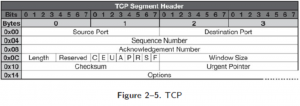Post 12: TCP & UDP
January 8, 2019 at | In Network Forensics | No CommentsTCP and UDP are one of the most well-known protocols. TCP, or transmission control protocol is a protocol that works with the IP to define how computers send packets of data to another computer, and vice versa. UDP, also known as user datagram protocol, is used to establish low-latency and loss-tolerating connections between internet applications.
Differences Between TCP and UDP
- TCP sends individual packets, while UDP sends messages, known as datagrams
- TCP is a reliable data transfer protocol, while UDP is unreliable when it comes to data transfer protocol
- TCP has segment sequencing, while UDP does not have sequencing
- TCP port range is from 0 – 65535. UDP port range is from 0 – 65536
- TCP is connection-oriented, while UDP is connectionless
TCP Header

UDP Header

Source:
- https://searchnetworking.techtarget.com/definition/TCP
- https://enterprise.netscout.com/edge/tech-tips/difference-between-tcp-and-udp
No Comments yet »
RSS feed for comments on this post. TrackBack URI
Leave a comment
Powered by WordPress with Pool theme design by Borja Fernandez.
Entries and comments feeds.
Valid XHTML and CSS. ^Top^